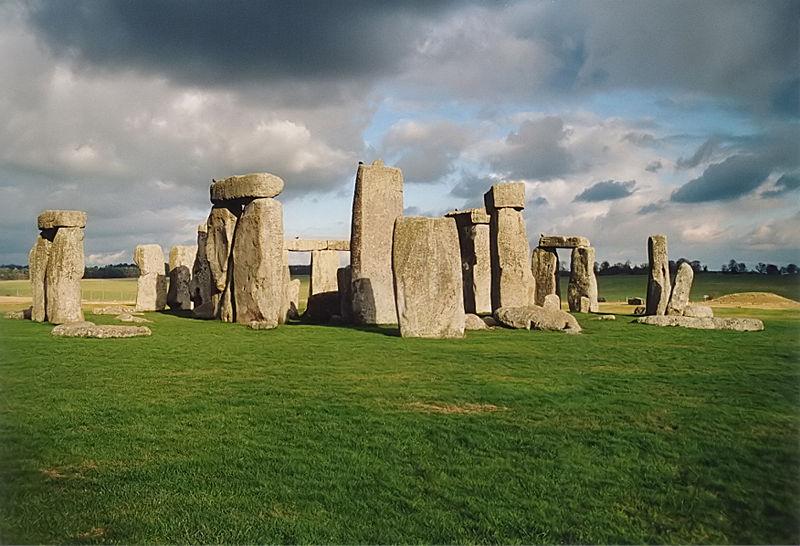
Megaliths
very large stones, surrounded in turn by a circular ditch (example is Stone hedge)
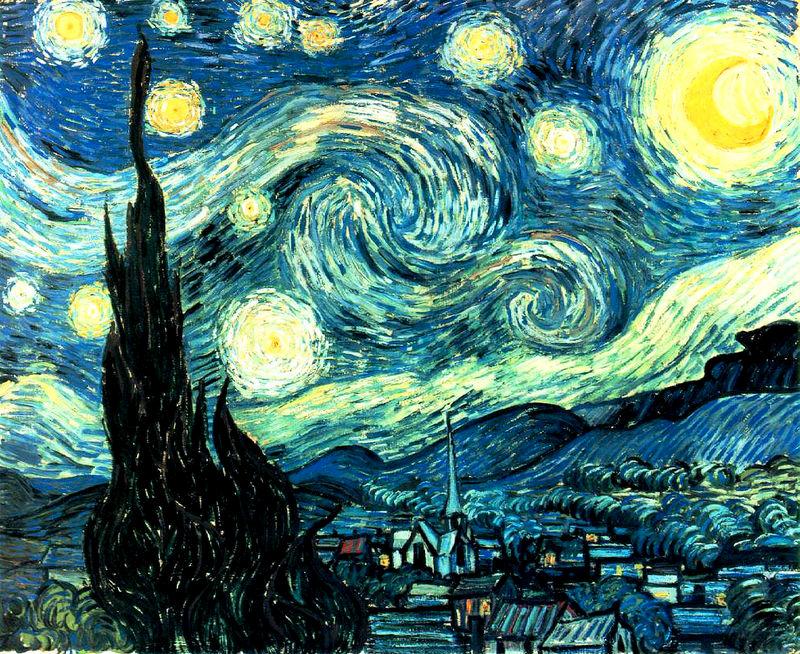
Vincent van Gogh's Starry Night
In The Starry Night (1.10), Vincent van Gogh labored to express his personal feelings as he stood on the outskirts of a small village
in France and looked up at the night sky. Van Gogh had become intrigued by the belief that people journeyed to a star after their death, and that there they continued their lives. “Just as we take the train to get to Tarascon or Rouen,” he wrote in a letter, “we take death to reach a star.”4 Seen through the prism of that idea, the night landscape inspired in him a vision of great intensity. Surrounded by halos of radiating light, the stars have an exaggerated, urgent presence, as though each one were a brilliant sun. A great wave
or whirlpool rolls across the sky—a cloud, perhaps, or some kind of cosmic energy. The landscape, too, seems to roll on in waves like an ocean. A tree
in the foreground writhes upward toward the stars as though answering their call. In the distance, a church spire points upward as well. Everything is in turbulent motion. Nature seems alive, communicating in its own language while the village sleeps.
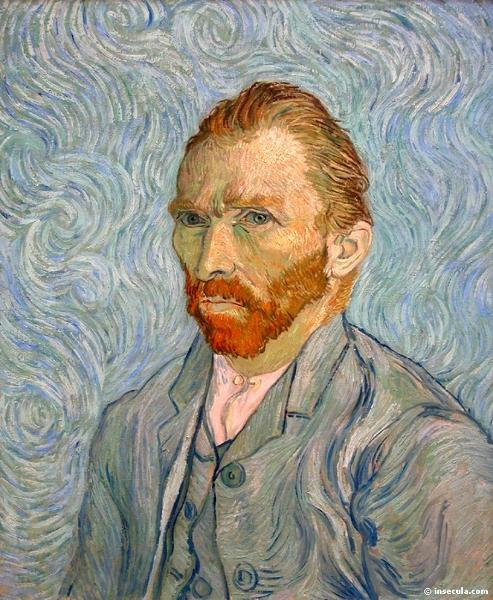
Vincent van Gogh Himself
Vincent van Gogh was born in the town of
Groot-Zundert, in Holland, the son of a Dutch Protestant minister. His early life was spent in various roles, including those of theological student and lay preacher among the miners of the region. Not until the age of twenty-seven did he begin to take a serious interest in art, and then he had but ten years to live. In 1886 he went to stay in Paris with his brother Theo, an art dealer who was always his closest emotional connection.
Two years later Van Gogh left Paris for the
southern city of Arles. There he was joined briefly by the painter Paul Gauguin, with whom Van Gogh
hoped to work closely, creating perfect art in a pure atmosphere of self-expression. However, the two artists quarreled, and, apparently in the aftermath of one intense argument, Van Gogh cut off a portion of his ear and had it delivered to a prostitute.
Van Gogh realized that his instability had gotten out of hand, and he committed himself to an asylum, where—true to form—he continued to work prolifically at his painting. Most of the work we admire so much was done in the last two and a half years of his life. Vincent (as he always signed himself) received much sympathetic encouragement during those years, both from his brother and from an unusually perceptive doctor and art connoisseur, Dr. Gachet, whom he painted several times. Nevertheless, his despair deepened, and in July of 1890 he shot himself to death.
Perception
seeing is a mode of perception, which is the recognition and interpretation of sensory data—in other words, how information comes into our eyes (ears, nose, taste buds, fingertips) and what we make of it.
Visual Perception
In visual perception, our eyes take in information in the form of light patterns; the brain processes these patterns to give them meaning. The role of the eyes in vision is purely mechanical. Barring some physical disorder, it functions the same way for everyone. The mind’s role in making sense of the information, however, is highly subjective and belongs to the realm of psychology. Simply put, given the same situation, we do not all notice the same things, nor do we interpret what we see in the same way.
Difference in Perception
One reason for differences in perception is the immense amount of detail available for our attention at any given moment. To navigate efficiently through daily life, we practice what is called selective perception, focusing on the visual information we need for the task at hand and relegating everything else to the background. But other factors are in play as well. Our mood influences what we notice and how we interpret it, as does the whole of our prior experience—the culture we grew up in, relationships we have had, places we have seen, knowledge we have accumulated.
Subjective Nature of Perception
The subjective nature of perception explains why a work of art may mean different things to different people and how it is that we may return to a favorite work again and again, noticing new aspects of it each time. It explains why the more we know, the richer each new encounter with art will be, for we will have more experience to bring to it. It explains why we should make every effort to experience as much art in person as possible, for physical dimensions also influence perception. The works reproduced in this book are miniaturized. Many other details escape reproduction as well. Above all, the nature of perception suggests that the most important key to looking at art is to become aware of the process of looking itself—to notice details and visual relationships, to explore the associations and feelings they inspire, to search for knowledge we can bring to bear, and to try to put what we see into words.
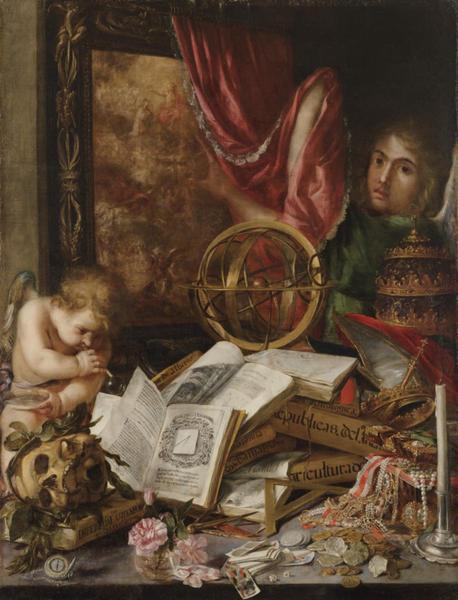
Juan de Valdés Leal’s Vanitas (OBSERVING)
Juan de Valdés Leal’s Vanitas (1.13) reveals a careless jumble of objects with a cherub looking over them. In the background, a man looks out at us from the shadows. But what are the objects? And what are the cherub and the man doing? Only if we begin to ask and answer such questions does the message of the painting emerge. In the foreground to the left is a timepiece. Next to it are three flowers, each one marking a stage in the brief life of a flower across time: budding, then blossoming, then dying as its petals fall away. Then come dice and playing cards, suggesting games of chance. A cascade of medals, money, and jewelry leads up to an elaborate crown, suggesting honors, wealth, and power. In center, books and scientific instruments evoke knowledge. Finally, a skull crowned with a laurel wreath lies on its side. Laurel raditionally crowns those who have become famous through their achievements, especially artistic achievements. Over this display the cherub blows a bubble, as though making a comment on the riches before him.
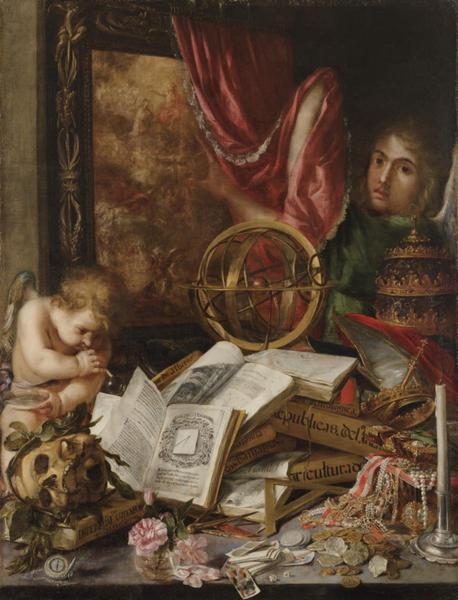
Juan de Valdés Leal’s Vanitas (OBSERVING) Continued...
A bubble’s existence is even shorter than a
flower’s—a few seconds of iridescent beauty, and then nothing. Behind the books, a crystal globe resembles a bubble as well, encouraging us to see a
connection. When we meet the man’s gaze, we notice that he has drawn back a heavy curtain with one hand and is pointing at a painting he has thus
revealed with the other. “Look at this,” he all but speaks. The painting depicts the Last Judgment. In Christian belief, the Last Judgment is the moment
when Christ will appear again. He will judge both the living and the dead, accepting some into Paradise and condemning others to Hell. The universe will end, and with it time itself.
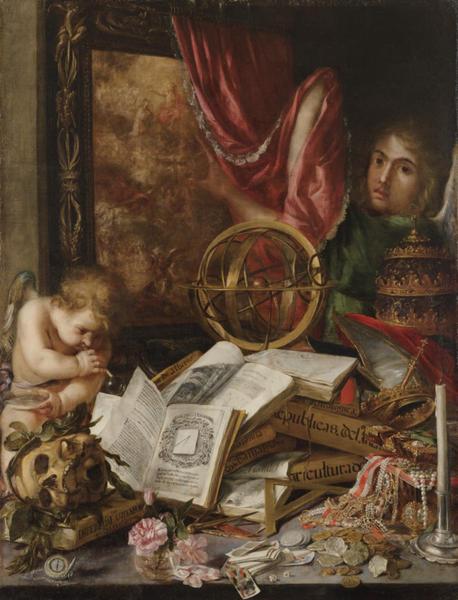
Juan de Valdés Leal’s Vanitas (MEANING)
The painting depicts the Last Judgment. In Christian belief, the Last Judgment is the moment when Christ will appear again. He will judge both the living and the dead, accepting some into Paradise and condemning others to Hell. The universe will end, and with it time itself.We might paraphrase the basic message of the painting something like this: “Life is fleeting, and everything that we prize and strive for during it is ultimately meaningless. Neither wealth nor beauty nor good fortune nor power nor knowledge nor fame will save us when we stand before God at
the end of the world.” Without taking the time to perceive and reflect on the many details of the image, we would miss its message completely.
Vanitas is Latin for “vanity.” It alludes to the biblical book of Ecclesiastes, a meditation on the fleeting nature of earthly life and happiness in
which we read that in the end, “all is vanity.” The title wasn’t invented or bestowed by the artist, however. Rather, it is a generic name for a subject
that was popular during his lifetime. Numerous vanitas paintings have come down to us from the 17th century, and together they show the many ways
that artists treated its themes.
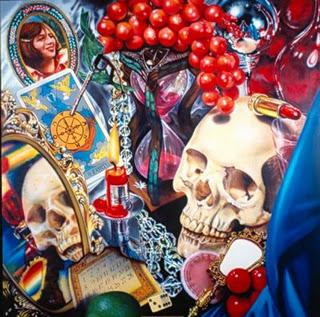
Audrey Flack's Wheel of Fortune (Vanitas)
Closer to our own time, the painter Audrey Flack became fascinated by the vanitas tradition, and she created a series of her own, including Wheel
of Fortune (Vanitas) (1.14). Knowing something of the tradition Flack is building on, we can more easily appreciate her updated interpretation. As
ever, a skull puts us in mind of death. An hourglass, a calendar page, and a guttering candle speak of time and its passing. The necklace, mirrors, powder puff, and lipstick are contemporary symbols of personal vanity, while a die and a tarot card evoke the roles of chance and fate in our lives. As in the painting by Valdés, a visual echo encourages us to think about a connection,
in this case between the framed oval photograph of a young woman and the framed oval reflection of the skull just below. Flack may be painting with one eye on the past, but the other is firmly
on our society as we are now.
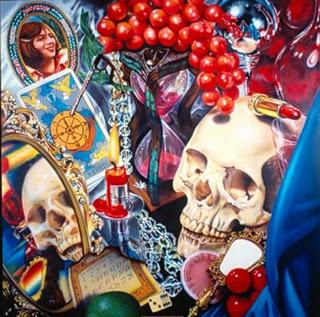
Audrey Flack's Wheel of Fortune (Vanitas) Continued.....
For example, she includes modern inventions such as a photograph and a lipstick tube, and she shuns symbols that no
longer speak to us directly such as laurels and a crown. The specifically Christian context is gone as well, resulting in a more general message that
applies to us all, regardless of faith: Time passes quickly, beauty fades, chance plays a bigger role in our lives than we like to think, death awaits.
Despite their differences, both Flack and Valdés provide us with many clues to direct our thoughts. They depict objects that have common associations
and then trust us to add up the evidence.
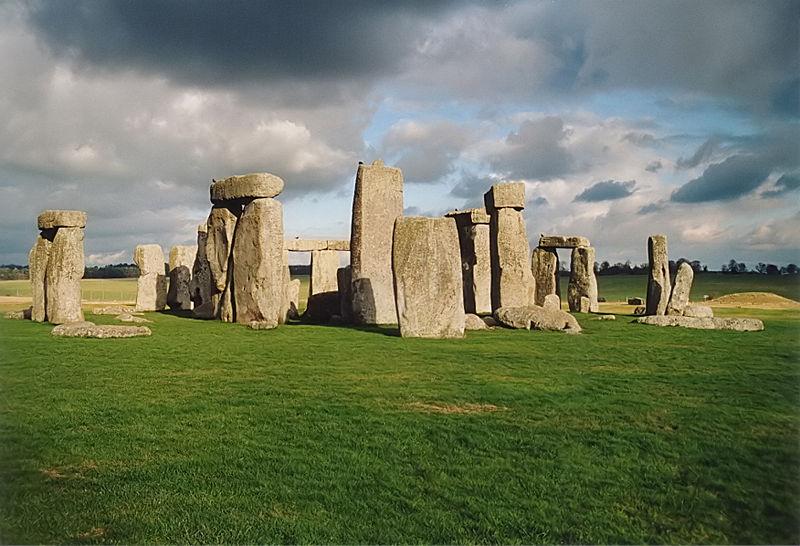
Stonehedge
The most impressive and haunting works to survive from the Stone Ages, the structure in the south of England known as Stonehenge (1.4). Today much ruined through time and vandalism, Stonehenge at its height consisted of several concentric circles of megaliths. It was built in several phases over many centuries, beginning around 3100 B.C.E. The tallest circle, visible in the photograph here, originally consisted of thirty gigantic upright stones capped with a continuous ring of horizontal stones. Weighing some 50 tons each, the stones were
quarried many miles away, hauled to the site, and laboriously shaped by blows from stone hammers until they fit together.
Many theories have been advanced about why Stonehenge was built and what purpose it served. Recent archaeological research has confirmed that the monument marks a graveyard, perhaps that of a ruling dynasty. The cremated remains of up to 240 people appear to have been buried there over a
span of some five hundred years, from the earliest development of the site until the time when the great stones were erected. Other findings suggest that the monument did not stand alone but was part of a larger complex, perhaps a religious complex used for funerary rituals. What is certain is that Stonehenge held meaning for the Neolithic community that built it.
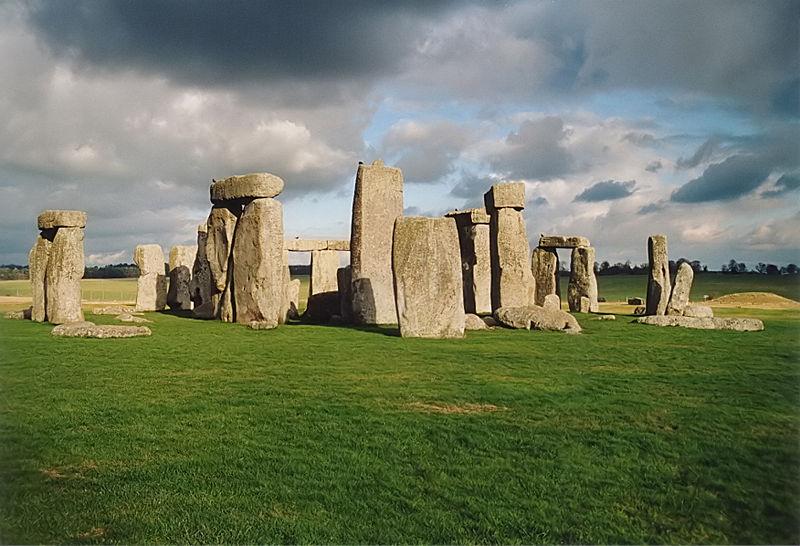
Stonehedge Continued....
What is certain is that Stonehenge held meaning for the Neolithic community that built it. For us,
it stands as a compelling example of how old and how basic is our urge to create meaningful order and form, to structure our world so that it reflects our ideas. This is another place where art begins. Stonehenge was erected in the Neolithic era, or New Stone Age. The Neolithic era is named for the new kinds of stone tools that were invented, but it also saw such important advances as the domestication of animals and crops and the development of the technology of pottery, as people discovered that fire could harden certain kinds of clay.
Neolithic
Stonehenge was erected in the Neolithic era, or New Stone Age. The Neolithic era is named for the new kinds of stone tools that were invented.
e.g. pile stone on stone like that of Stonehedge
Paleolithic
Upper Paleolithic Period, which simply means the latter part of the Old Stone Age.
e.g. soot and grease on cave walls such as those of Chauvet Cave
Kente
Woven in West Africa by artists of the Asante people, it is a spectacular example of a type of textile known as kente.
Kente is woven in hundreds of patterns, each with its own name, history, and symbolism.
Traditionally, a newly invented pattern was shown first to the king, who had the right to claim it for his own exclusive use. Like the Neolithic vessel, royal kente was reserved for ceremonial occasions. Rich, costly, and elaborate, the
cloth distinguished its wearer as special as well, an extraordinary version of an ordinary human being.
Selective Perception
Science tells us that seeing is a mode of perception, which is the recognition and interpretation of sensory data—in other words, how information comes into our eyes (ears, nose, taste buds, fingertips) and what we make of it. In
visual perception, our eyes take in information in the form of light patterns; the brain processes these patterns to give them meaning. The role of the eyes in vision is purely mechanical. Barring some physical disorder, it functions the same way for everyone. The mind’s role in making sense of the information, however, is highly subjective and belongs to the realm of psychology. Simply put, given the same situation, we do not all notice the same things, nor do we interpret what we see in the same way.
One reason for differences in perception is the immense amount of detail available for our attention at any given moment. To navigate efficiently through daily life, we practice what is called selective perception, focusing on the visual information we need for the task at hand and relegating everything else to the background. But other factors are in play as well. Our mood
influences what we notice and how we interpret it, as does the whole of our prior experience—the culture we grew up in, relationships we have had,
places we have seen, knowledge we have accumulated.
Selective Perception Continued...
The subjective nature of perception explains why a work of art may mean different things to different people and how it is that we may return
to a favorite work again and again, noticing new aspects of it each time. It explains why the more we know, the richer each new encounter with art will be, for we will have more experience to bring to it. It explains why we should make every effort to experience as much art in person as possible, for physical dimensions also influence perception. The works reproduced in this book are miniaturized. Many other details escape reproduction as well.
Above all, the nature of perception suggests that the most important key to looking at art is to become aware of the process of looking itself—to
notice details and visual relationships, to explore the associations and feelings they inspire, to search for knowledge we can bring to bear, and to try to put what we see into words.
Aesthetics (Part of Chapter 1 vocabulary but not found in Chapter 1)
The branch of philosophy concerned with the
feelings aroused in us by sensory experiences such as seeing and hearing. Aesthetics examines, among other things, the nature of art and the nature of beauty.
Visual Arts (Part of Chapter 1 vocabulary but not found in Chapter 1)
In the visual arts as in other areas of life, style is the result of a series of choices, in this case choices an artist makes in creating a work of art. As we grow more familiar with a particular artist’s work, we begin to see a recurring pattern to these choices—characteristic subject matter or materials, distinctive ways of drawing or of applying paint, preferences for certain colors or color combinations. For example, now that you have seen three paintings by Van Gogh (1.10, the self-portrait on page 11, and 2.1), you can see
certain traits they have in common, such as heightened color, thickly applied paint, distinct brush strokes, distorted and exaggerated forms, and flame like or writhing passages. Each subsequent work by Van Gogh that you come across will fine-tune what you already know about his style, just as
what you already know will provide a framework for considering each new work.